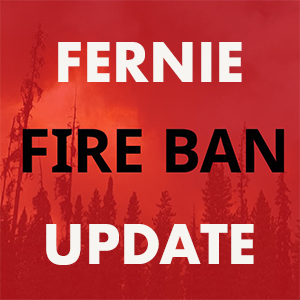
(PHOTO: Dinosaur Footprint. Dinosaur footprint (30cm across) from the coal measures in the Upper Elk Valley. Photo by Bob Morris.)
Author: Bob Morris
Way back in 1845, Father Jean de Smet, a missionary working with the Kootenay Indians saw large pieces of coal along the river, and wrote, “I am convinced that this fossil could be abundantly procured.” Michael Phillipps was the first prospector to recognize the potential of coal in the area, but it was William Fernie who obtained the first coal prospecting licences in 1889, and by late 1897 mining had begun at Coal Creek
Today, the biggest mine in the valley is the Fording River mine, which plans to produce 9.2 million tonnes of clean coal this year*. The mine moves up to 69-million-cubic metres of waste rock to release the coal, ranking it as one of the biggest mines in the world. The rock moved by the mine is equivalent to moving the Great Pyramid of Cheops every 11 days.

(PHOTO: Miner. Coal mining is Fernie’s heritage. With the influx of new people and all the change the valley has seen in the past 10 to 20 years, it’s easy ot forget why the valley was first developed. We’ve seen ups and downs in the local economy for more than 100 years, generally because of the fluctuations in the coal market. Photo courtesy of Fernie Historical Society)
The present day mines in the valley utilize open pit mining methods where large trucks and shovels remove rock to expose the coal seams. A typical mining sequence includes drilling and blasting rock above the coal seam, usually in 15m high benches (level working areas). Rock waste is loaded onto haul trucks by shovel (three to four-bucket loads per truck) and is then transferred to waste dumps. The exposed coal is pushed into a pile with a bulldozer and put into haul trucks by a loader. This “raw” coal is washed in the preparation plant to remove most of the rock impurities. The “clean” coal is then stored in large silos until it’s loaded onto a train.
The unit trains are up to 120 cars long and carry more than 13,000 tonnes of coal per train. If the market value of this coal is $50/tonne, each trainload is worth more than $650,000. On average, there are four to six coal trains travelling through Fernie each day.
Our coal is not used to produce electricity (steam or thermal coal),
as it is too valuable. The majority of the coal is transported by train to Roberts Bank, just south of Vancouver, for boat transport to southeast Asia, Brazil, and as far away as Iran. These countries use the coal to make coke for their steel industries.
The mines at Coal Creek produced more than 18 million tonnes of coal from 1897 to 1958. In the late 1960’s our coal was recognized for its high metallurgical qualities for steel making and there is now more than 20-million tonnes of coal mined from five Elk Valley mines each year, with a market value of $1.3 billion.

(PHOTO: Truck. World’s largest truck under construction in the mid 1970’s, today found at Sparwood’s info center. Photo by Bob Morris.)
But we also have the real black gold. An oil seep in the lower Flathead River valley was drilled in 1956, and in the early 1990’s Chevron and Mobil Oil combined to test the area with a single hole, but came up dry. The question now is whether the mother lode is still waiting to be found.
*Statistics are for 2001.


























